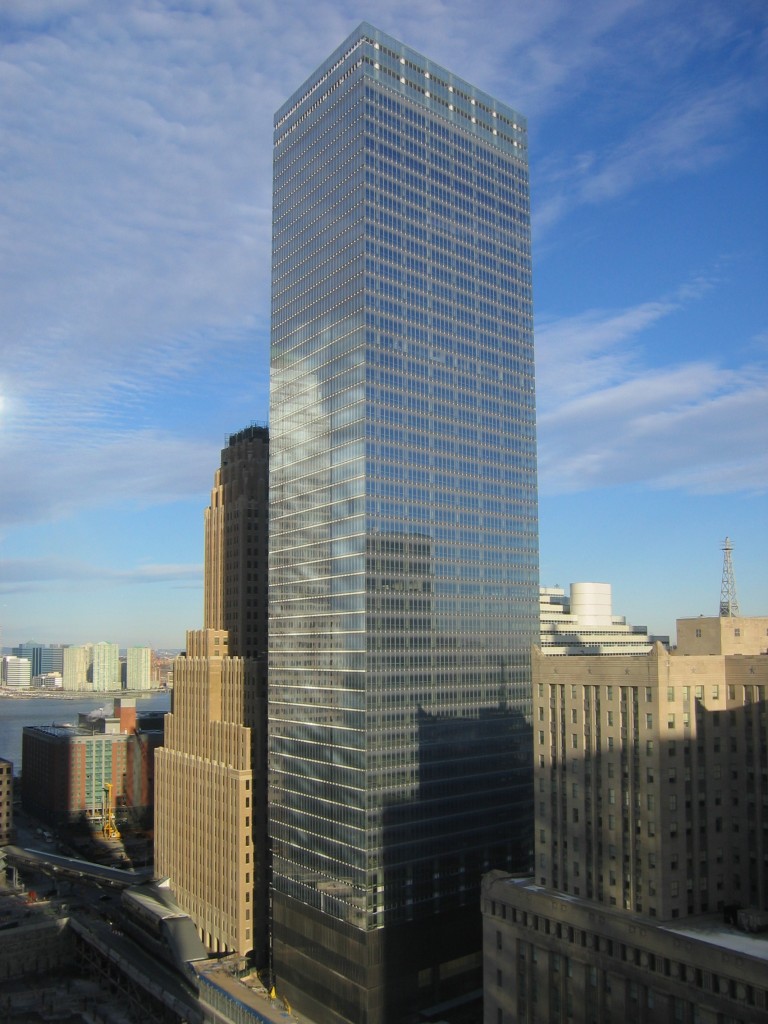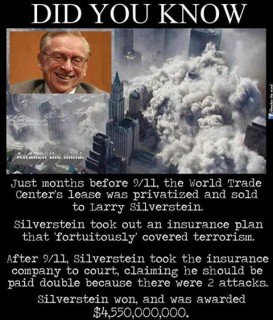- Welcome to September 11, 2001 Research & Archives.
September 11, 2001 Research & Archives
We Will Never Forget!
Recent posts
#21
The Bin Laden's, Terrorists or Business Partners / The Bush Family Has More Links...
Last post by Archangel - August 07, 2017, 07:03:11 PM
5-30-2009 .yourbbsucks.com
"The Bush Family Has More Links To The Bin Laden Family" Than Saddam Hussein
One of my favorite talks was given by Dr. Michael Parenti entitled, "Terrorism, Globalization, and Conspiracy." In it, he says, "he (Saddam Hussein) didn't have links to that guy (Osama Bin Laden). The Bush family has more links to the Bin Laden family." I laugh every time I hear it, but in actuality, it's very sad. Thanks to www.historycommons.org
1988: Bin Ladens Bail Out George W. Bush?
Prior to this year, President George W. Bush is a failed oilman. Three times, friends and investors have bailed him out to keep his business from going bankrupt. However, in 1988, the same year his father becomes president, some Saudis buy a portion of his small company, Harken, which has never performed work outside of Texas. Later in the year, Harken wins a contract in the Persian Gulf and starts doing well financially. These transactions seem so suspicious that the Wall Street Journal in 1991 states it "raises the question of... an effort to cozy up to a presidential son." Two major investors in Bush's company during this time are Salem bin Laden and Khalid bin Mahfouz. Salem bin Laden dies in a plane crash in Texas in 1988. [INTELLIGENCE NEWSLETTER, 3/2/2000; SALON, 11/19/2001] Salem bin Laden is Osama's oldest brother; Khalid bin Mahfouz is a Saudi banker with a 20 percent stake in BCCI. The bank will be shut down a few years later and bin Mahfouz will have to pay a $225 million fine (while admitting no wrongdoing) (see October 10, 2001)). [FORBES, 3/18/2002]
June 4, 1992: FBI Investigates Ties Between George W. Bush and Saudi Money
The FBI investigates connections between James Bath and George W. Bush, according to published reports. Bath is Salem bin Laden's official representative in the US. Bath's business partner contends that, "Documents indicate that the Saudis were using Bath and their huge financial resources to influence US policy," since George W. Bush's father is president. George W. Bush denies any connections to Saudi money. What becomes of this investigation is unclear, but no charges are ever filed. [HOUSTON CHRONICLE, 6/4/1992]
November 1998: Former President George H. W. Bush Meets with Bin Laden Family
Former President George H. W. Bush meets with the bin Laden family on behalf of the Carlyle Group. The meeting takes place in Jeddah, Saudi Arabia. [SUNDAY HERALD (GLASGOW), 10/7/2001]
January 2000: Former President Bush Meets with bin Laden Family on Behalf of Carlyle Group
Former President George H. W. Bush meets with the bin Laden family on behalf of the Carlyle Group. He had also met with them in November 1998 (see November 1998), but it is not known if he meets with them again after this. Bush denies this meeting took place until a thank you note is found confirming that it took place. [WALL STREET JOURNAL, 9/27/2001; GUARDIAN, 10/31/2001]
Late January 2001: US Intelligence Told to Back Off from Bin Laden and Saudis
The BBC later reports, "After the elections, [US intelligence] agencies [are] told to 'back off' investigating the bin Ladens and Saudi royals, and that angers agents." This follows previous orders to abandon an investigation of bin Laden relatives in 1996 (see February-September 11, 1996), and difficulties in investigating Saudi royalty. [BBC, 11/6/2001] An unnamed "top-level CIA operative" says there is a "major policy shift" at the National Security Agency at this time. Bin Laden could still be investigated, but agents could not look too closely at how he got his money. One specific CIA investigation hampered by this new policy is an investigation in Pakistani nuclear scientist A. Q. Khan and his Khan Laboratories. Khan is considered the "father" of Pakistan's nuclear weapons capability. But since the funding for this nuclear program gets traced back to Saudi Arabia, restrictions are placed on the inquiry. [PALAST, 2002, PP. 99-100] Also in early 2001, FBI agent Robert Wright, attempting to pursue an investigation into Saudi multimillionaire Yassin al-Qadi, is told by FBI superiors, "it's just better to let sleeping dogs lie"(see January-March 2001). Reporter Greg Palast notes that President Clinton was already hindering investigations by protecting Saudi interests. However, as he puts it, "Where Clinton said, 'Go slow,' Bush policymakers said, 'No go.' The difference is between closing one eye and closing them both." [PALAST, 2002, PP. 102]
(8:00 a.m.) September 11, 2001: Former President George H. W. Bush Heads off After Spending Night at the White House
Former President George H. W. Bush, along with former First Lady Barbara Bush, leaves Washington, DC, by private jet, bound for a speaking engagement in St. Paul, Minnesota. The Bushes spent the previous night at the White House. They had flown to Washington the previous day to attend several meetings and a dinner. One of the meetings attended by the former president was the annual investor conference of the Carlyle Group, which was also attended by Shafig bin Laden, one of Osama bin Laden's brothers (see (9:00 a.m.) September 11, 2001). They are later informed of the WTC attacks while on their jet. Due to all planes being grounded, they have to land in Milwaukee, Wisconsin. [CBS NEWS, 11/1/2002; CNN, 10/25/2003; NEWSWEEK, 10/27/2003]
(9:00 a.m.) September 11, 2001: Bin Laden Brother Attends Carlyle Group Conference
The Carlyle Group is a large private-equity investment firm, closely associated with officials of the Bush and Reagan administrations, and has considerable ties to Saudi oil money, including ties to the bin Laden family. This morning it is holding its annual investor conference at the Ritz Carlton hotel in Washington, DC. Among the guests of honor is investor Shafig bin Laden, brother of Osama bin Laden. [OBSERVER, 6/16/2002; LONDON TIMES, 5/8/2003]
Former President George H. W. Bush, who makes speeches on behalf of the Carlyle Group and is also senior adviser to its Asian Partners fund [WALL STREET JOURNAL, 9/27/2001] , attended the conference the previous day, but is not there today (see (8:00 a.m.) September 11, 2001). [WASHINGTON POST, 3/16/2003]
#22
The Bin Laden's, Terrorists or Business Partners / Bush & Bin Laden
Last post by Archangel - August 07, 2017, 06:39:07 PM
|
#23
The Bin Laden's, Terrorists or Business Partners / September 13, 2001 Private Fli...
Last post by Archangel - August 07, 2017, 06:37:07 PMThe Denver Post
While all flights were halted following the terrorist attacks, there was one exception made: The White House authorized planes to pick up 140 Saudi nationals, including 24 members of the bin Laden family, living in various cities in the U.S. to bring them back to Saudi Arabia, where they would be safe. They were never interrogated. By Cindy Rodríguez |
Plane Carried 13 Bin Ladens
Manifest of Sept. 19, 2001, Flight From U.S. Is Released
Manifest of Sept. 19, 2001, Flight From U.S. Is Released
By Dana Milbank Washington Post Staff Writer Thursday, July 22, 2004; Page A07 At least 13 relatives of Osama bin Laden, accompanied by bodyguards and associates, were allowed to leave the United States on a chartered flight eight days after the Sept. 11, 2001, attacks, according to a passenger manifest released yesterday. One passenger, Omar Awad bin Laden, a nephew of the al Qaeda leader, had been investigated by the FBI because he had lived with Abdullah bin Laden, a leader of the World Assembly of Muslim Youth, which the FBI suspected of being a terrorist organization. The passenger list was made public by Sen. Frank Lautenberg (D-N.J.), who obtained the manifest from officials at Boston's Logan International Airport. Lautenberg's office was given the document in recent weeks and released it before today's issuance of the final report of the commission investigating the Sept. 11 attacks. Although much was already known about the "bin Laden flight," Lautenberg provided additional details, including the information that the plane, a 727 owned by DB Air and operated by Ryan International, began its flight in Los Angeles and made stops in Orlando, Dulles International Airport and Boston before continuing to Gander, Newfoundland; Paris; Geneva; and Jiddah, Saudi Arabia. The aircraft, tail number N521DB, has been chartered frequently by the White House for the press corps traveling with President Bush. A staff report by the Sept. 11 commission this spring said the flight was one of six chartered flights carrying 142 people, mostly Saudi nationals, from the United States between Sept. 14 and 24 after airspace was reopened. The U.S. government had allowed, before commercial airspace was reopened, at least one domestic flight for Saudis who had feared for their safety, Lautenberg's staff said. The commission reported that there were 23 passengers and three private security guards on the bin Laden flight. However, the manifest lists 25 passengers, plus the three guards employed by CDT Training Inc. of Elmwood Park, N.J. After a request for permission to allow the bin Ladens to leave reached Richard A. Clarke at the National Security Council, the flight departed Logan Airport in Boston at 11 p.m. on Sept. 19, 2001. Dale Watson, former FBI counterterrorism chief, said yesterday that FBI agents "scrubbed the people who were leaving, and I was informed none of them were anybody we needed to detain or not allow to leave." Lautenberg, in a statement, said that Bush "needs to explain to the American people why his administration let this plane leave." White House spokesman Sean McCormack said the contentions that the flight should not have been allowed to leave have been "debunked by the facts." Ron Ryan of Ryan International said yesterday that he is "quite confident" that the Saudi Embassy arranged the flight through a Ryan partner called Sport-Hawk. He said the bin Ladens "were quite concerned for their safety," which alarmed the crew. "The Saudi Embassy offered to pay more money if our crew had a concern," he said. But he said all were reassured because "the FBI and Secret Service were heavily involved. They were in abundance every place we were." The commission staff reported that each of the Saudi flights "was investigated by the FBI and dealt with in a professional manner prior to its departure." The staff said that 22 people on the bin Laden flight were interviewed by the FBI and that the FBI checked databases for information on the passengers. The commission said none of the passengers was on the terrorist watch list. The flight manifest lists 13 people with the bin Laden surname and others with Brazilian, British, Indonesian and Yemeni passports. Passenger Omar Awad bin Laden had lived with Abdullah bin Laden, a nephew of Osama bin Laden who was involved in forming the U.S. branch of the World Assembly of Muslim Youth in Alexandria. Federal agents raided the office this spring in connection with a terrorism-related investigation. The FBI has described the group as a "suspected terrorist organization." Among the other passengers was Shafig bin Laden, a half brother of Osama bin Laden who was reportedly attending the annual investor conference of the Carlyle Group, a politically connected investment company in Washington, on Sept. 11, 2001. Also on board was Akberali Moawalla, an official with the investment company run by Yeslam bin Laden, another of Osama bin Laden's half brothers. Records show that a passenger, Kholoud Kurdi, lived in Northern Virginia with a bin Laden relative. The bin Laden flight has received fresh publicity because it was a topic in Michael Moore's anti-Bush documentary, "Fahrenheit 9/11." Researcher Margot Williams and staff writer Susan Schmidt contributed to this report. © 2004 The Washington Post Company |
#24
The Luckiest Investor Alive... / Larry Silverstein Designed New...
Last post by Archangel - August 06, 2017, 11:26:15 AM | 9/11: Larry Silverstein Designed New WTC-7 One Year Before Attacks Larry Silverstein was caught admitting on camera that he planned to build an entirely new World Trade Center 7 (WTC-7) building one year before the 9/11 attacks had occurred. By Sean Adl-Tabatabai | Your News Wire | March 16, 2016 |
Back in April 2000, one year and five months before the attacks, "Lucky Larry" held a meeting to discuss plans to replace building 7 in 2002. As reported by Veterans Today: "We got the designs. And the first design meeting was in April of 2000. And construction began shortly thereafter, in 2002." Watch Larry Silverstein – New WTC7 designed in 2000: |
| https://911researcharchives.org/911/videos/Larry Silverstein - New WTC7 designed in 2000.mp4 | One slight problem: If he hadn't been planning the illegal, un-permitted, homicidal demolitions of WTC-7 and the entire World Trade Center complex that took place on September 11th, 2001, there would have been no point to any such design meeting back in April, 2000 ... and no opportunity for beginning construction of a new WTC-7 in 2002. With the supreme chutzpah that has become his trademark, Silverstein breezes over the demolitions of 9/11/2001 as if they were not even worth remarking on, instead going straight from his new-WTC-7 design meeting in April 2000 to the beginning of construction in 2002. In 2001, "Lucky Larry," who had previously owned only WTC-7, orchestrated a deal with his fellow-ultra-Zionist Lewis Eisenberg, Chairman of the mobbed-up NY Port Authority, and another Zionist extremist billionaire, Frank Lowy, to sell the entire WTC complex to Silverstein and backers on a 100-year lease. The deal was finalized in July, 2001, and Larry took possession of the buildings ... and security arrangements. But first, he hard-balled his insurers into doubling the terror insurance coverage and changing the terms to "instant cash payout." The new, 52-story 7 World Trade Center. On September 11th, Larry hit the jackpot. The condemned-for-asbestos and largely vacant Twin Towers, with their obsolete communications infrastructure and money-hemorrhaging balance sheet, were both demolished for free – with 3,000 people inside. |
| Larry should have been at the Windows on the World restaurant at the top of the North Tower, just like every other day. Fortunately, he tells us, his wife reminded him of a dermatologist appointment. His daughter, who always took breakfast with him, made a similarly lame excuse. Both survived ... and prospered ... while everyone above the 91st floor, including everyone who showed up to have breakfast at Windows on the World, died miserable deaths. |
|
#25
The Luckiest Investor Alive... / WTC Insurance Fraud?
Last post by Archangel - August 06, 2017, 10:56:07 AMWTC insurance fraud? Silverstein "trial" runs Monday through Wednesday By Kevin Barrett on July 15, 2013
|
#26
September 11, 2001 Timeline / American Airlines Manager Asks...
Last post by Archangel - August 03, 2017, 10:33:28 PMCraig Marquis, the manager on duty at the American Airlines System Operations Control (SOC) center in Fort Worth, Texas, instructs Peggy Houck, a dispatcher at the SOC, to calculate how far Flight 11 could travel with the fuel it has left. [American Airlines, 9/11/2001, pp. 20-22; 9/11 Commission, 11/19/2003 pdf file; 9/11 Commission, 1/8/2004 pdf file]
Marquis was recently told by a colleague at the SOC that FAA air traffic controllers are treating Flight 11 as a hijacking (see 8:40 a.m. September 11, 2001). [9/11 Commission, 11/19/2003 pdf file; 9/11 Commission, 7/24/2004, pp. 6]
He now talks to Houck and tells her that Flight 11 has "turned off his transponder." He says controllers have the plane "on primary radar and they see him descending." Marquis then asks Houck to calculate how far the plane could go with its current amount of fuel. He says: "Could you run me a model? Flight 11 is currently 66,000 pounds of gas back from the time I got the call. Just give me some sort of endurance for 25,000 feet, if you would." [American Airlines, 9/11/2001, pp. 20-22]
Marquis is also on the phone with Nydia Gonzalez, a supervisor at the American Airlines Southeastern Reservations Office in North Carolina who is simultaneously participating in a call with Betty Ong, a flight attendant on Flight 11. [9/11 Commission, 11/19/2003 pdf file; 9/11 Commission, 8/26/2004, pp. 8-9]
Marquis updates Gonzalez on what is happening. He tells her, "I have the dispatcher currently taking the current fuel on board, and we're gonna run some profiles to see exactly what [Flight 11's] endurance is." [American Airlines, 9/11/2001, pp. 20-22]
Houck will perform an analysis of the fuel capacity of Flight 11 and determine that the plane has "an approximate range of six hours." [Federal Bureau of Investigation, 9/11/2001, pp. 5-7]
She will tell the 9/11 Commission that, around this time, she thinks the situation with Flight 11 is "looking like a typical hijacking.... She was thinking they might be headed to Cuba or Colombia." [9/11 Commission, 1/8/2004 pdf file]
Marquis was recently told by a colleague at the SOC that FAA air traffic controllers are treating Flight 11 as a hijacking (see 8:40 a.m. September 11, 2001). [9/11 Commission, 11/19/2003 pdf file; 9/11 Commission, 7/24/2004, pp. 6]
He now talks to Houck and tells her that Flight 11 has "turned off his transponder." He says controllers have the plane "on primary radar and they see him descending." Marquis then asks Houck to calculate how far the plane could go with its current amount of fuel. He says: "Could you run me a model? Flight 11 is currently 66,000 pounds of gas back from the time I got the call. Just give me some sort of endurance for 25,000 feet, if you would." [American Airlines, 9/11/2001, pp. 20-22]
Marquis is also on the phone with Nydia Gonzalez, a supervisor at the American Airlines Southeastern Reservations Office in North Carolina who is simultaneously participating in a call with Betty Ong, a flight attendant on Flight 11. [9/11 Commission, 11/19/2003 pdf file; 9/11 Commission, 8/26/2004, pp. 8-9]
Marquis updates Gonzalez on what is happening. He tells her, "I have the dispatcher currently taking the current fuel on board, and we're gonna run some profiles to see exactly what [Flight 11's] endurance is." [American Airlines, 9/11/2001, pp. 20-22]
Houck will perform an analysis of the fuel capacity of Flight 11 and determine that the plane has "an approximate range of six hours." [Federal Bureau of Investigation, 9/11/2001, pp. 5-7]
She will tell the 9/11 Commission that, around this time, she thinks the situation with Flight 11 is "looking like a typical hijacking.... She was thinking they might be headed to Cuba or Colombia." [9/11 Commission, 1/8/2004 pdf file]
#27
September 11, 2001 Timeline / New York Center Controller Inf...
Last post by Archangel - August 03, 2017, 10:29:20 PM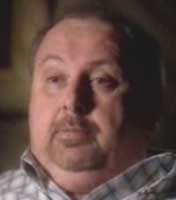 Dave Bottiglia. [Source: ABC News] | After American Airlines Flight 11 appears on his radar screen, Dave Bottiglia, an air traffic controller at the FAA's New York Center, is informed that this aircraft is suspected of having been hijacked. Flight 175 entered Bottiglia's airspace not long before this (see 8:40 a.m. September 11, 2001). [MSNBC, 9/11/2002; 9/11 Commission, 8/26/2004, pp. 20] Its pilot has just told Bottiglia about the "suspicious transmission" (presumably from Flight 11) he heard while departing Boston airport (see 8:41 a.m.-8:42 a.m. September 11, 2001). [Gregor, 12/21/2001 pdf file] Seconds later, American Airlines Flight 11 also enters the area Bottiglia is monitoring and its target appears on his radar screen. The controller sitting next to Bottiglia gets up and points to the radar blip. He says: "You see this target here? This is American 11. Boston Center thinks it's a hijack." Bottiglia will later recall that his initial thought about Flight 11, based on this information, is that the hijackers "were probably going to Cuba." As its transponder has been turned off (see (Between 8:13 a.m. and 8:21 a.m.) September 11, 2001), he has no altitude information for Flight 11, but can tell from the radar scope that it appears to be descending. According to author Lynn Spencer: "Even without a transponder, controller radars calculate ground speed for all radar targets, and when a plane is descending, the ground speed decreases. The flight had been 'grounding' 600 knots, and now it has decreased to 320." Bottiglia follows Flight 11's target on his radar screen until it disappears over New York City. [MSNBC, 9/11/2002; Spencer, 2008, pp. 37] |
Because he is focused on Flight 11, Bottiglia will not notice when Flight 175's transponder code changes at 8:47 (see 8:46 a.m.-8:47 a.m. September 11, 2001). [9/11 Commission, 7/24/2004, pp. 21; 9/11 Commission, 8/26/2004, pp. 21] The New York Center was first notified of Flight 11's hijacking at 8:25 a.m. (see 8:25 a.m. September 11, 2001), though this information was not passed on to Bottiglia. [Federal Aviation Administration, 9/17/2001 pdf file; Spencer, 2008, pp. 36-37] |
#28
September 11, 2001 Timeline / Flight 11 Attendant Amy Sweene...
Last post by Archangel - August 03, 2017, 10:16:34 PM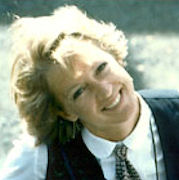 Dianne Snyder. [Source: Family photo] | Amy Sweeney, a flight attendant on Flight 11, tells an American Airlines manager at Logan International Airport in Boston that the passengers in the coach section of her plane believe there is simply a routine medical emergency at the front of their plane. [ABC News, 7/18/2002; 9/11 Commission, 7/24/2004, pp. 6] Sweeney, who is sitting at the back of the coach section of Flight 11, phoned the American Airlines flight services office at Logan Airport at 8:32 a.m. Since then, she has been describing the trouble on her plane to Michael Woodward, an American Airlines flight services manager (see (8:32 a.m.-8:44 a.m.) September 11, 2001). [New York Observer, 2/15/2004; 9/11 Commission, 8/26/2004, pp. 11] Sweeney now tells Woodward that the passengers in the coach section are calm, and under the impression that there is a routine medical emergency in the first class section of the plane. Presumably this means they are unaware that their plane has been hijacked. Sweeney says three flight attendants—Jeffrey Collman, Sara Low, and Dianne Snyder—are attending to duties, such as getting medical supplies, while she and Betty Ong are reporting events over the phone. [ABC News, 7/18/2002; 9/11 Commission, 1/25/2004 pdf file; 9/11 Commission, 8/26/2004, pp. 14] |
(Ong is another flight attendant, who is sitting next to Sweeney and is talking on the phone with the American Airlines Southeastern Reservations Office in North Carolina (see 8:19 a.m. September 11, 2001 and 8:21 a.m. September 11, 2001). [9/11 Commission, 8/26/2004, pp. 8, 11] ) |
#29
September 11, 2001 Timeline / American Airlines Manager Tell...
Last post by Archangel - August 03, 2017, 10:13:36 PMCraig Marquis, the manager on duty at the American Airlines System Operations Control (SOC) center in Texas, tells Nydia Gonzalez, a supervisor at the American Airlines Southeastern Reservations Office in North Carolina, that FAA air traffic controllers are handling Flight 11 as a "confirmed hijacking." [American Airlines, 9/11/2001, pp. 7-19]
Gonzalez is one of several employees at the reservations office who are on the phone with Betty Ong, a flight attendant on Flight 11 who has been describing to them the trouble on her plane. Gonzalez has been relaying the information Ong provides to Marquis. [9/11 Commission, 11/19/2003 pdf file; 9/11 Commission, 8/26/2004, pp. 8-9]
She asks him, "What's going on on your end, Craig?" [American Airlines, 9/11/2001, pp. 7-19]
Marquis has just been told by a colleague at the SOC that FAA controllers are treating Flight 11 as a hijacking (see 8:40 a.m. September 11, 2001). [9/11 Commission, 11/19/2003 pdf file; 9/11 Commission, 7/24/2004, pp. 6]
He therefore replies: "We contacted air traffic control. They are gonna handle this as a confirmed hijacking. So they're moving all the traffic out of this aircraft's way." He says that Flight 11 has its "transponder off, so we don't have a definitive altitude for him." Marquis adds that FAA controllers "seem to think that they have [Flight 11] on a primary radar. They seem to think that he is descending." [American Airlines, 9/11/2001, pp. 7-19]
Gonzalez is one of several employees at the reservations office who are on the phone with Betty Ong, a flight attendant on Flight 11 who has been describing to them the trouble on her plane. Gonzalez has been relaying the information Ong provides to Marquis. [9/11 Commission, 11/19/2003 pdf file; 9/11 Commission, 8/26/2004, pp. 8-9]
She asks him, "What's going on on your end, Craig?" [American Airlines, 9/11/2001, pp. 7-19]
Marquis has just been told by a colleague at the SOC that FAA controllers are treating Flight 11 as a hijacking (see 8:40 a.m. September 11, 2001). [9/11 Commission, 11/19/2003 pdf file; 9/11 Commission, 7/24/2004, pp. 6]
He therefore replies: "We contacted air traffic control. They are gonna handle this as a confirmed hijacking. So they're moving all the traffic out of this aircraft's way." He says that Flight 11 has its "transponder off, so we don't have a definitive altitude for him." Marquis adds that FAA controllers "seem to think that they have [Flight 11] on a primary radar. They seem to think that he is descending." [American Airlines, 9/11/2001, pp. 7-19]
#30
September 11, 2001 Timeline / Fighter Pilots Unofficially To...
Last post by Archangel - August 03, 2017, 10:04:49 PM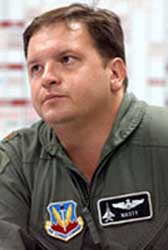 Major Daniel Nash. [Source: Cape Cod Times] | Major Daniel Nash (codenamed Nasty) and Lieutenant Colonel Timothy Duffy (codenamed Duff) are the two F-15 pilots who would scramble after Flight 11. Apparently, they get several informal calls warning to get ready. According to Nash, at this time, a colleague at the Otis Air National Guard Base tells him that a flight out of Boston has been hijacked, and that he should be on alert. [Cape Cod Times, 8/21/2002] NEADS senior technician Jeremy Powell (informed about the hijacking at 8:37 a.m.), says that he telephones Otis Air National Guard Base soon thereafter to tell it to upgrade its "readiness posture." [Newhouse News Service, 1/25/2002] Boston flight control had tried calling the Otis base directly at 8:34 a.m., although the result of that call remains unclear. Duffy recalls being warned: "I was just standing up by the ops desk and I was told I had a phone call. I asked who it was and they said the [Boston] tower calling and something about a hijacking. It was Flight American 11, a 767, out of Boston going to California. At the time we ran in and got suited up." [Aviation Week and Space Technology, 6/3/2002; Cape Cod Times, 8/21/2002; BBC, 9/1/2002] At NEADS, the mission crew commander Major Kevin Nasypany orders his Weapons Team, which controls the fighters, to put the Otis planes on "battle stations." This means the two "alert" pilots are "jolted into action by a piercing 'battle horn.' They run to their jets, climb up, strap in, and do everything they need to do to get ready to fly short of starting the engines." [Vanity Fair, 8/1/2006] |
NEADS Commander Robert Marr is also reported as having ordered the Otis pilots to battle stations. [Filson, 2003, pp. 55; 9/11 Commission, 7/24/2004, pp. 20] Duffy confirms, "Halfway to the jets, we got 'battle stations'... which means to get ready for action." [Aviation Week and Space Technology, 6/3/2002] The actual scramble order does not come until the pilots are already waiting in the fighters: "We went out, we hopped in the jets and we were ready to go—standby for a scramble order if we were going to get one." [BBC, 9/1/2002] Duffy continues, "I briefed Nasty on the information I had about the American Airlines Flight. About four-five minutes later, we got the scramble order and took off." [Aviation Week and Space Technology, 6/3/2002] However, the official notification to scramble these fighters does not come until 8:46 a.m. The six-minute (or more) delay between unofficial and official notification has not been explained. |
